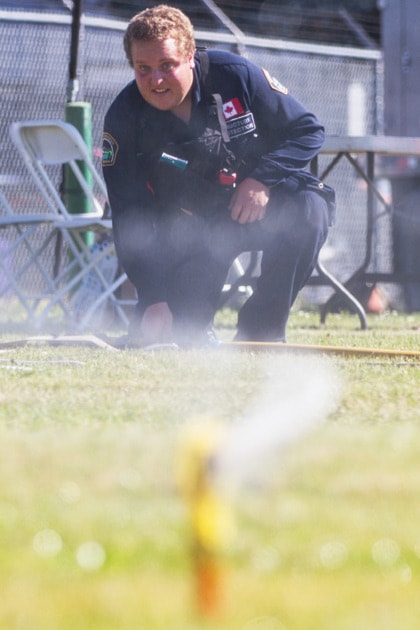Even when the temperature is soaring to mid-30s and beyond, it’s hard to burn a wet, soggy mess.
This is something the 80-plus members of the Shuswap Emergency Program’s Structural Protection Unit rely on.
“If we know a fire is going to hit an area, we like to set up a couple of days in advance,” says team leader Jake Jacobson, who has 30 years of experience with the Salmon Arm Fire Department’s Hall 4 and 33 with the BC Forest Service’s Wildfire Protection Branch. “The unit provides protection rather than firefighting.”
A team of five highly trained firefighters from Sicamous, Salmon Arm and Columbia Shuswap Regional District fire halls head out with a trailer rigged out with hoses of several sizes and a 3,000-gallon water bladder or relay tank.
“We’re two to three days ahead of the fire,” says Mike Engholm, a team leader and Scotch Creek-Lee Creek fire chief. “We can be deployed within an hour or two but it often takes time to get there.”
Each trailer can be used to protect up to 25 structures, depending on size of property, the number of structures and their proximity to one another.
“If the houses are close together, 15 to 20, to 25 homes can be protected,” says Mike Engholm. “If rural properties are well apart, they might only be able to provide coverage for one.”
Five-person teams are deployed to the potential path of a wildfire under order from B.C’s Office of the Fire Commissioner.
Working in twos or threes, members then assess each property, completing individual assessment forms that include a detailed description of each structure, the presence of propane, skylights, decks, roof type, siding material, power lines, natural gas and items in the vicinity of structures, such as firewood piled against a home.
The assessment also details the presence of a water source and a space for a site diagram that indicates the placement of buildings on each property.
Assessment determines whether a property does not need defending, is defendable with preparation or cannot be saved.
Depending on the amount of work required, team members will remove potential fuel sources from the side of homes before setting up hoses to thoroughly wet down the area surrounding the structure.
“If firewood is piled against a house, we’ll move it away – if it’s two or three cords,” says Engholm. “If it’s a pile of lumber sitting by a house, we will just sprinkle it.”
He says preparation time depends on water availability and simplicity of the process, which is where property owners come in.
“Probably the biggest thing is to make sure people are aware of the FireSmart Manual,” adds Engholm, encouraging property owners to do their part in protecting their homes. “It is a two prong-program, we protect with the unit, but it is so critical to educate the public to do their part. If we have 50 homes to protect, we will go to ones that can easily be used (to set up sprinklers).”
A structural protection unit was first deployed from the Lower Mainland and Saskatchewan to protect homes in Notch Hill Estates along Davies Road during the 2009 Notch Hill wildfire.
“Houses were protected and probably the biggest thing was we protected an old cedar mill,” says SEP co-ordinator Cliff Doherty. “I was up there and was amazed at how it went from a dry tinderbox ready to burn to…”
“A wet, soggy mess,” interjects Engholm. “Wet fuel doesn’t burn and it doesn’t take long to do that.”
Since 2009 the regional district has acquired two structural protection units and SEP is seeking board approval for a third unit.
“It’s a really strong move on the part of local government, really proactive in keeping fires out of people’s homes,” says Jacobson who, like Engholm, agrees there needs to be a combination of protection and a program to reduce the fuel load in forests around communities.
“Our fuel load is a hundred times more than it should be,” Jacobson says. “Even 100 metres into the forest- it creates a defensive space… If there is less fuel on the ground, it’s easier for us to get in there.”
